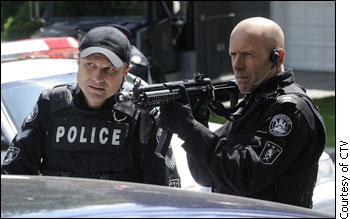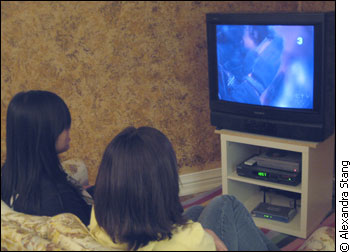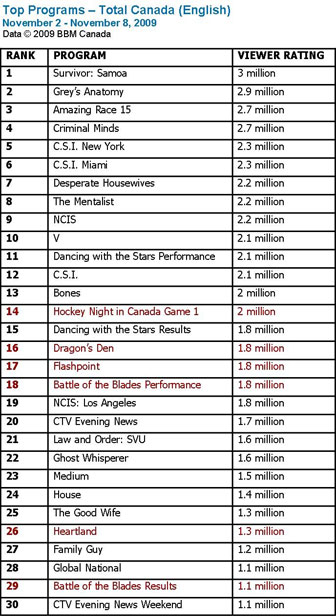Tags
Related Posts
Share This
Canadian television’s coming of age
Remember several years ago when you would tune-in to CBC or CTV for the latest homegrown drama series? Shows like Road to Avonlea and Cold Squad seemed cheap and corny compared to shows on American networks.
“A few years ago Canadian dramas were said to have a ‘look,’” says Denis McGrath, council member of the Writers Guild of Canada.
He describes it as a look that featured flat lighting and static shooting, and that reeked of a low budget. In addition, the writing and editing were bad and the subject matter was dull, lacking the conflict we are used to seeing in American dramas.
Those days are quickly fading into the past, as Canada’s television industry continues to evolve. More than ever, the lines between Canadian and American drama series are blurring. Rather than recognizing a Canadian show by its low-budget appearance, viewers are recognizing it for the Tim Hortons cup in the lead character’s hand.

Flashpoint, with its many fans on both sides of the 49th, proves that Canadian dramas can have all the appeal of U.S. ones.
“I remember the days when ‘Oh my god, this is so bad it must be Canadian’ was what people said,” says Valerie Creighton, President and CEO of the Canadian Television Fund. “And I think we are way past that.”
Canadian television is getting better, and more and more Canadians are choosing to watch programs made and set in their home and native land.
Flashpoint, CTV’s police drama based on the Toronto Police Emergency Task Force, set a ratings record earlier this season with 1.8 million viewers tuning in. Compare that to big-budget American programs like Grey’s Anatomy, which also airs on CTV and averages about 3 million Canadian viewers per episode: Flashpoint looks like a competitor. And it is not the only Canadian-made program to be generating buzz.
“If you look today at shows like Flashpoint which are often being talked about — Being Erica, Durham County — they have critical acclaim from the U.S.; they’re sold around the world,” says Creighton.
She says audience ratings are paramount, as obviously nobody wants to make a television show that goes unwatched. However, critical acclaim and award nominations are also important indicators of strong, creative programming.
Twenty-year-old Queen’s University student Lauren Tight is an avid TV viewer. She says she watches a lot of American programs, like Gossip Girl and Grey’s Anatomy, but also is a fan of several Canadian shows, including the Rick Mercer Report, Flashpoint and Being Erica.
“I used to not watch Canadian TV — it was awful,” she claims.
‘I remember the days of ‘Oh my god, this is so bad it must be Canadian.’ I think we are way past that.’ — Valerie Creighton, Canadian Television Fund.
More recently, however, Tight has noticed a change in the programming being developed in Canada. She says the storylines, scripts and acting have improved.
“You can tell it’s not as cheap as it used to seem,” she says.
And that is a big part of the change. Creighton says the Canadian Television Fund increased its production budgets for English drama series by 48 per cent last year as compared to six years ago. She says this difference is reflected in the quality of programming being made now, and that Canadian TV obviously will benefit from further investment.
“Like any industry — you could look to oil and gas or agriculture — if you spend some time and money investing in the sector, supporting people who do the work, eventually you end up with a really good consumer product,” she explains.
Let’s do it our way
Thanks to increased funding, Canada’s television industry is starting to find its stride; but money isn’t everything. Creative talent — writers, directors, actors — is what really makes or breaks a show. And taking new paths, instead of following the pack, might be the formula for creating great, successful Canadian television programs.
“The important thing about Flashpoint is that it’s not trying to copy something that’s already on a U.S. network,” says Alex Strachan, national TV critic for Canwest News Service.
This judgment is proven out by a viewing of any Flashpoint episode: the show is not trying to be anything but itself. It has its own compelling characters and storylines — not obviously drawn from U.S. models — and, rather than emphasizing the Canadian backdrop, it simply uses it.
McGrath has similar thoughts. “Rather than trying to do a pale photocopy of a U.S. cop show, how about a show like Slings and Arrows? When the New York Times saw that, they raved because nobody had ever done a show like that in the States.”
Unlike Flashpoint, which has seen mainstream success, Slings and Arrows found its niche on pay-TV channels like Movie Central and The Movie Network. The show, loosely based on the behind-the-scenes action at Canada’s Stratford Shakespeare Festival, lasted for three seasons from 2003 to 2006. With a team that included comedy writer Mark McKinney (The Kids in the Hall, Saturday Night Live) and actor Paul Gross (Men With Brooms, Passchendaele), the show garnered praise from critics on both sides of the border.

Erin Karpluk in CBC’s hit Being Erica. CBC’s short season format (13 episodes) helps its shows to concentrate on better scripts.
Strachan describes Slings and Arrows as a “boutique show.” It had a small but loyal following , and that’s why it worked on pay-TV. He says other Canadian television shows, such as Durham County, a dark show about the secrets of suburbia, can benefit from this model.
“Durham County was never going to be a mainstream hit, which is why it can survive and do its job on The Movie Network,” he says.
He says CBC tends to operate like a pay-TV channel when it comes to scheduling and marketing their programs. Instead of 22 episodes per season, there are only 13. Perhaps that’s why Being Erica has been successful. According to Strachan the future of good Canadian television drama is this model, especially if homegrown programs want to remain competitive in a market dominated by American shows.
Canadian but not self-consciously so
It is clear there has been a shift in Canadian productions. Creighton says in the earlier days the focus was too much on being “Canadian” rather than on being entertaining. It’s likely that Canadian-content regulations are to blame for this.
“I would rather see one ambitious, heartfelt drama like The Line or Durham County than two hundred shitty reality shows with some kind of Canadian angle,” says Strachan. Unfortunately, he adds, the CRTC`s regulations are more about the amount of Canadian content produced rather than the quality of the content itself.
McGrath says the way to good television is to make the show the most important thing, and put political and cultural concerns aside. He says when this happens, writers and directors can concentrate on telling fun, entertaining stories.

More and more Canadians now choose to watch homegrown fare, such as Flashpoint and Hockey Night in Canada.
Sometimes, however, the Canadian angle is what Canadian viewers find appealing. For example, Tight says she likes Rick Mercer’s humour because it’s about Canada and being Canadian.
“I like Being Erica for similar reasons, but at the same time, it’s entertaining — I wouldn’t watch it if it weren’t,” she explains. “But because it’s Canadian, I like it more.”
Of course, there are still some people out there who won’t give a Canadian drama series the time of day because they assume it’s terrible. McGrath says that attitude is outdated — as well as typifying some Canadians’ tendency toward self-loathing.
“All the stuff about Canadian TV ‘sucking’ got said about Canadian music in the 1960s,” he explains. “Today, if you said something like ‘All Canadian music sucks,’ most people would rightly call you out with a dozen or twenty examples that show how ridiculous a blanket statement that is.”
However, according to Creighton, when there are a couple million people watching a program like Flashpoint, it’s clear that many Canadians are starting to see the value of our homegrown programming.
“Even when something we do is great, it takes someone else — not us — telling us it’s great before we’ll believe it,” says McGrath. “This is kind of sad. The good news is that we’re slowly trying to change that perception. And we’re winning.”
Weekly viewership figures for the top 30 programs, both reality and scripted, currently aired in Canada. Canadian-made shows appear in red.
Related Links






